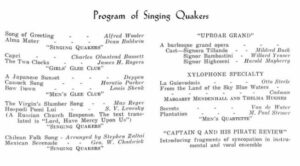Campbell continued to use the name “Combined Glee Clubs” for an unidentified amount of time. But concert programs revealed that after 1930, only the name “Singing Quakers” was used to identify the ensemble.


Campbell continued to use the name “Combined Glee Clubs” for an unidentified amount of time. But concert programs revealed that after 1930, only the name “Singing Quakers” was used to identify the ensemble.

During the Great Depression, the university was forced to pursue significant faculty and budget cuts. To help cushion the budget once again, the Singing Quakers increased their number of performances to help raise money for the institution. Their thirty concerts included performances at local churches, music organizations and on radio..Read More
Alan Irwin replaced Roy Campbell as department head. Described as a “jolly little round man with a great love for opera,” Irwin led the Singing Quakers through seven years of opera performances that included elaborate staging, lighting effects, and costumes.
Irwin started producing annual holiday concerts. The first concert was a collaborative effort between the Singing Quakers and Wichita’s First Presbyterian Church Choir. The 130-member chorus and five soloists performed sections of J. S. Bach’s Christmas Oratorio.

Irwin’s era was known as the “opera years.” After the success of The Gondoliers, a production complete with sets and costumes designed by professionals from the community, multiple operas were programmed year after year.
Waldo Neilsen took over leadership of the Singing Quakers for one year. Coming from an A Capella background, Neilsen wanted to start an additional ensemble that would be voices only. He named this touring choir the “A Cappella Choir” to distinguish it from the Singing Quakers.

Charles Finney became director of the Singing Quakers. Due to global and economic stress of World War II, music tours were difficult to organize and support as the country’s attention focused on the war effort. Finney replaced the spring tour with a spring opera, planned during a Music Department Music..Read More

Because of World War II, male students were forced to join the war effort, making the Singing Quakers a nearly an all-women ensemble for a number of years. While Finney remained the Music Department head, voice faculty member, Elsa Haury directed the women’s chorus. Haury kept the ensemble busy, performing..Read More

At the end of WWII, enrollment increased from 192 to 410 making the Singing Quakers a large, mixed ensemble, once again. John Duro, who replaced Haury and Finney, led the ensemble for just a year.

Fred C. Mayer was selected as head of the Music Department and director of the Singing Quakers. Mayer had been directing ensembles since his high school years and majored in orchestral conducting at Capital University. While at Friends University, he was eager to reestablish choir tours. These tours proved to..Read More